The Problem:
What to do when springs start ‘sprunging’ from your favorite chair’s seat bottom?
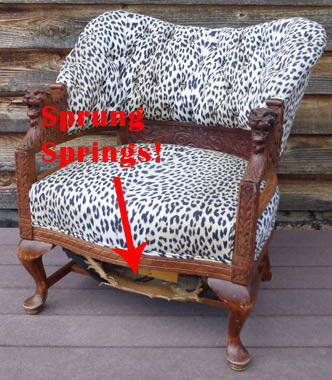
Keeping the upholstery fabric was paramount to the owner of this chair – she just wanted to save the springs!
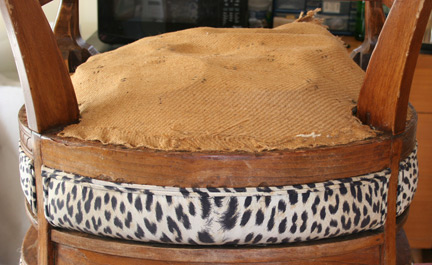
This chair did not even have true webbing – just a heavy burlap to hold the springs in place. Notice the tiny metal clips holding the springs on the burlap.
The Solution:
Stretch the webbing across the bottom of your chair: Begin at center front-to-back, then center side-to-side. Work to each side and toward front and back, weaving the webbing as you go. Follow the numbered order in the infographic below.
There are several different types of webbing stretchers available. My personal favorite is the gooseneck style. See demo video to learn how to stretch webbing here.
How tight to stretch the webbing? Remember, you do not want to stretch the webbing too tight, or your chair’s glued joints will eventually loosen and fail. If you hear cracking, then it’s likely too tight. However, it should be tight enough to make a drum-like sound when ‘plucked’.
On this chair, since the old webbing was still holding the springs in their original position, it was left attached to the springs, and carefully detached from the chair rails in steps as the new webbing was stretched over it. The springs were then stitched to the new webbing with button twine and a curved needle to keep them in the correct position after the fix.
Got a bigger problem that warrants tearing your chair down to the springs? See this related post: ‘How to Tie Upholstery Springs without a Manual’.
Want to learn more? Stay informed when new upholstery tips & techniques are posted: Subscribe to our mailing list.
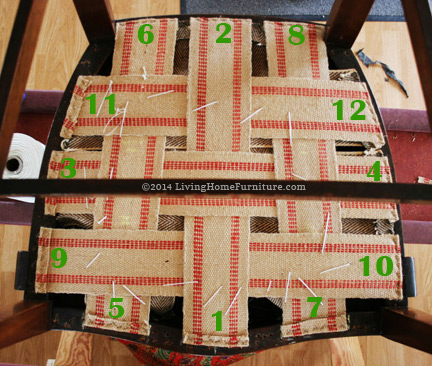
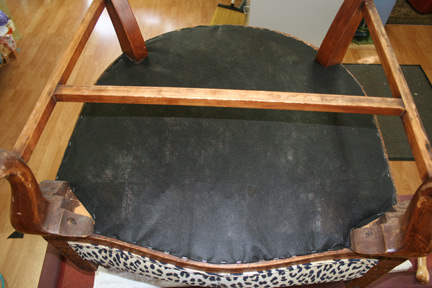
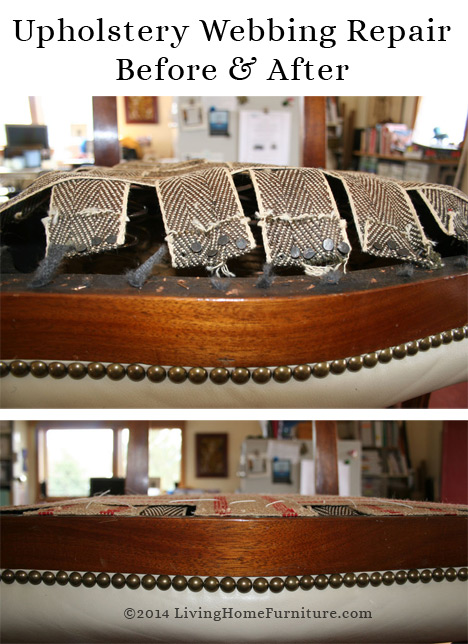
Hi Carla
I have an old sentimental chair handed down by my late mother… Unfortunately our dog ate the burlap webbing underneath and I want to have a go at fixing it..
Could i sent you a photo and ask for your advise as to whether or not it is indeed fixable
Thank you for your advice here, all very informative
All the best
Niall
Hi Niall,
I’m glad you’re finding this helpful. Yes, you can send your image(s) to carla@naturalupholstery.com and I will post a response here in the comments section so that others with a similar problem may benefit.
Thanks!
Carla
Question submitted via email on 8/15/17:
Help! My sofa was sagging. Too many kids and dogs. I digress. The webbing was black-edged so I replaced with red-edged, leaving the pretty fabric alone. Okay that’s a total lie. It’s Harvest Gold fabric like my mom’s old refrigerator but I’m too broke to change it. Refer to the part about kids and dogs. Now, how do I make the coils stay put on the bottom end? Curved needle and twine? Fishing line? My kids vote for zip ties ( they love the zzzzip sound) but that sounds like a bad joke waiting to be told. Many thanks in advance.
Sarah
—
(my answer)
Hi Sarah,
Yes, a curved needle and button twine is the best way to secure the springs to the webbing on the bottom end.
Good luck!
Carla
—
You are my hero! Um…heroine? None of the other websites had the crucial word…BUTTON twine. There are so many, hairy, unthready, scraggly types of twine! Many thanks for saving my sofa!!!
Wow! what a wonderful blog you have. Thank you for sharing.
Thanks Nathan,
I see you have a green upholstery cleaning service there in NYC.
Cheers from Montana!
Carla
Thanks so much! This site was both inspiring and helpful! Finished my “web repair” yesterday.
So glad it’s been helpful, Darlene!
This is really informative. Can you explain how you “carefully detached from the chair rails in steps as the new webbing was stretched over it”. Do you do one new web strip and them cut the old one off the rail. I am redoing a settee and have 4 broken strips but want to leave the upholstery as it is.
Hi Sandy,
Thanks for a great question!
I detach the old webbing strip from the rail (remove all staples/tacks) before stretching the new web strip on. This avoids having two webbing layers at the edges. I have seen this done where the new strip was just stretched over the top of the old, which I don’t do because it creates a lumpy finish.
I hope this helps,
Carla
This is a big help. I am going to tackle this project this week. Thanks for all your assistance.
Hi Carly. I have the exact problem (seemingly no webbing) with a Louis XV style needlepoint chair. Thanks for sharing this tutorial. I do need to replace and/or reinforce my padding when I’m in there, too, so I have 2 questions for you.
I’d like to disrupt the spring positioning as little as possible, since I have no experience and am also worried I couldn’t perfectly achieve the proper fit/placement if replacing the seat entirely. Could I successfully wedge padding (maybe cut into quarters) between the existing foam and the springs to reinforce it instead of removing it, or would that approach be difficult and likely to provide poor results? Also, should I worry about “over-stuffing” or select a particular type of filler? I’m thinking of picking up two quantities of this 22×22” foam from Home Depot… https://www.homedepot.com/p/FUTURE-FOAM-2-in-Thick-Multi-Purpose-Foam-10030BULK2/203837080?source=shoppingads&locale=en-US
Please let me know your thoughts. I would greatly appreciate any input you might have!
Hi Alisha,
It sounds like your chair really needs to be reupholstered, though I do understand the premise of saving the needlepoint seat. Your description makes me think the spring tying may be failing at the seat level on your chair as well as at the webbing level. this is a much stickier problem. Honestly, I think trying to wedge the padding in from the bottom will likely provide poor results, whatever padding you choose. I would not discourage you from trying, but I would say brace yourself for disappointment. I haven’t seen the Home Depot foam, but my guess is that it is ‘craft’ quality (much like Joann’s) and not suitable for upholstery.
any sources for quality uphostery padding/stuffing? I can’t find anything other than foam available in the US.
Hi, I have a Duncan Phyfe love seat. Should I put the new webbing over the old? If so, should I sew each spring onto the new? Also, some of the spring string is broken. Should I re-tie all springs? Thanks!
Hi Joyce,
It sounds like your sofa’s springs need an entire overhaul, with new webbing, and springs retied. Unfortunately this can’t be done without tearing it back and reupholstering the entire piece with new fabric, etc. If you’re not ready to reupholster, you CAN buy time by making reinforcements from the bottom, attaching new webbing on top of the old, and sewing the springs to the new webbing. However, if the spring string is rotten and breaking, it will eventually need to be fully and properly restored.
Check out this resource page for natural upholstery materials that might help :)
Hi Carla – I just stumbled over your site as a result of querying whether a sofa’s bottom webbing could be replaced without reupholstering the entire piece. I inherited my grandparent’s beautiful button-tufted love seat, made before 1938 (when the Chicago company went out of business after the owner’s death!). The upholstery is in wonderful condition, the only issue is that the bottom webbing has broken/rotted/ripped and the springs sag to the floor. It looks like they are correctly tied at the seat level & that webbing seems to be OK. Thanks for the great idea, and also for mentioning the button string!